The Back Room
The Back Room: Keys Open Doors
This week: the (physical) space race returns, a pay-to-display scheme in Chelsea, new horizons for the Chicago Imagists, and much more.
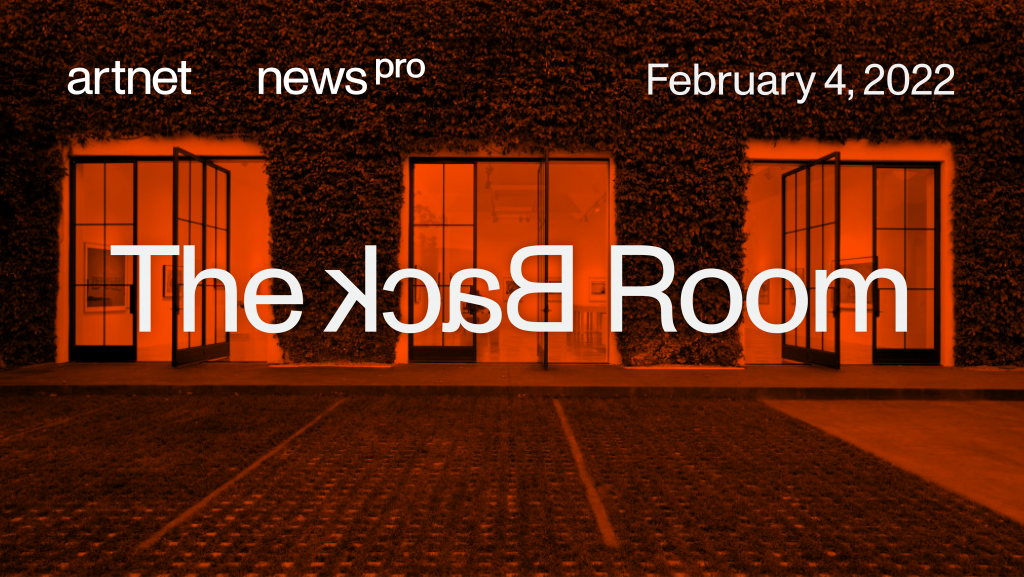
This week: the (physical) space race returns, a pay-to-display scheme in Chelsea, new horizons for the Chicago Imagists, and much more.

Tim Schneider

Every Friday, Artnet News Pro members get exclusive access to the Back Room, our lively recap funneling only the week’s must-know intel into a nimble read you’ll actually enjoy.
This week in the Back Room: the (physical) space race returns, a pay-to-display scheme in Chelsea, new horizons for the Chicago Imagists, and much more—all in a 7-minute read (2,066 words).
__________________________________________________________________________
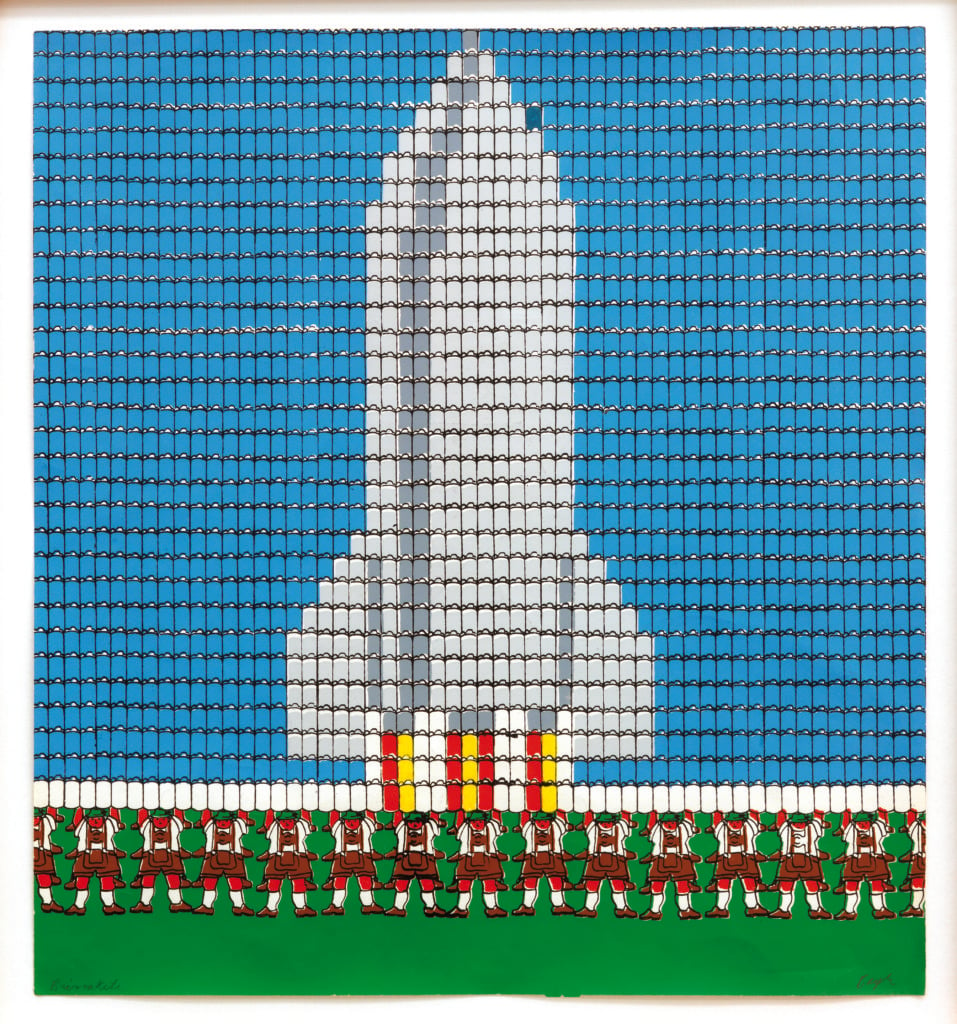
Thomas Bayrle, Bierrakete (Beer Rocket) (1969). Photo by Wolfgang Günzel.
Almost two years ago, COVID thrust the art market into a sustained stretch of chaos. Shutdowns, layoffs, and emergency-relief efforts dominated the media cycle from March to midsummer of 2020. Then, as a recovering economy translated into increasingly strong art sales, much of the trade was able to transition from survival mode to stability over the ensuing year.
Since last September, however, the business has pivoted again—this time, back into its pre-pandemic growth mentality. At least 26 for-profit art companies have announced or completed significant physical expansions in the past five months, with more on the way.
The latest example arrived Wednesday, when Pace announced a “partnership” that will see Los Angeles’s Kayne Griffin gallery become a 15,000-square-foot, fully staffed Pace L.A. this April.
Bill Griffin and Maggie Kayne, the founders and partners of Kayne Griffin, will become managing partners at Pace in the deal. Beyond James Turrell and Mary Corse, who the two galleries have long co-represented, the rebranded space will retain select artists on Kayne Griffin’s roster, with some to be added to Pace’s international program, according to a Pace spokesperson.
This news arrives only days after we learned that Art Basel will add a Paris fair and MCH Group had acquired a minority stake in the Singapore fair Art SG (both covered here last Friday).
But these headline-snatching scale-ups are only the most recent manifestations of a trend well underway. Spanning sectors and price tiers, the following activity—all announced since September—suggests that the 2020s have begun angling toward a 2010s-style quest for scale…
Art-Fair Organizers
Auction Houses
Mega-Galleries
International Gallery Expansions
U.S. Gallery Additions
Local Upgrades
Why so many expansions lately? For art sellers, the main tailwinds are months of robust sales results and pandemic-era cost savings. Many dealers found more success than expected by replacing expensive (and largely cancelled) live art fairs with cheap online viewing rooms for at least six months, while also cutting as many expenses as possible during the darkest days of COVID.
I suspect real-estate price pressures are another factor. Rents are only rising in major markets, and borrowing money in the U.S. will only get more expensive after Federal Reserve officials telegraphed an interest-rate increase in March (with more hikes on the table later in 2022). Scaling up can also be a defensive maneuver for smaller companies in our consolidating, winner-takes-all market.
But no matter the causes, the growth surge signifies that much of the art market is past the pandemic even if the pandemic isn’t fully past the art market. Yes, select fairs and other art events are still being rescheduled or cancelled as a result of the virus and its logistical complications, but plenty of others are forging ahead as planned—and being rewarded for it.
__________________________________________________________________________
The good news is that the adjustments made to weather COVID have been enough to prevent scores and scores of art businesses from closing during the crisis.
The bad news is that we now have five months’ worth of data suggesting that the most appealing idea the trade could conjure during 18 months of crises and soul-searching was to double down on scaling up.
That’s fine in many cases. Plenty of artists and dealers deserve more space to work with, and growing sales forces in new regions has served merchants well for centuries.
But if you were hoping COVID would spark a large-scale revolution in the art trade, it’s time to recognize that the old thinking simply kept working too well during the rupture to make abandoning it later seem wise. Now, even as entrepreneurs in every sector set out to aggressively redraw the art-market map, in one sense we find ourselves right back where we were before.
____________________________________________________________________________
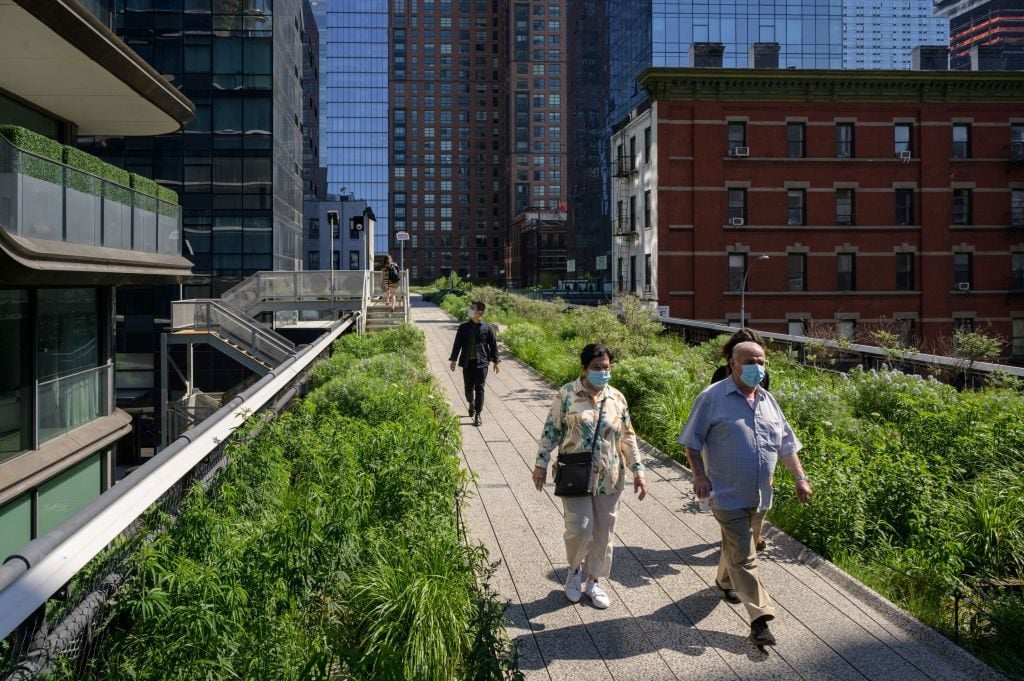
Just below the High Line, a gallery is charging artists for representation… (Photo by ED JONES/AFP via Getty Images)
In the latest Wet Paint, we learned that New York’s little-known Agora Gallery (“located in Chelsea, the art district of the world,” according to a staffer’s introductory email) charges artists up to $17,850 a year for representation—and a $50 fee to even assess a portfolio. Yikes!
Meanwhile, fast-rising figurative artist Jonathan Lyndon Chase took to Instagram to accuse fellow artist Mohammed Laouli of ripping off his work, an allegation that prompted Yossi Milo gallery to drop Laouli before even giving him an online show, then apologize to Chase for the “ugly situation.” Life comes at you fast!
Here’s what else made a mark around the industry since last Friday morning…
Art Fairs
Florence Bourgeois has been named the new head of the FIAC and Paris Photo art fairs, replacing 18-year veteran Jennifer Flay… amid rumors that Flay is decamping to run Art Basel Paris. (The Art Newspaper)
Adriana Farietta was appointed deputy director of the Armory Show after four years at the Texas public collection Ballroom Marfa. (Press release)
Auction Houses
Galleries
Francesco Longenecker has joined Petzel as a director. An alumnus of Pace, Cheim and Read, and Pace/MacGill, Longenecker will focus on secondary-market sales. (Press release)
Rome’s T293 gallery was the latest victim of a “man in the middle” cyber attack, with at least one collector wiring $33,000 to a scammer’s account in the hope of nabbing a coveted work by Anna Park. (Artnet News)
Institutions
The former director of Artissima art fair, Ilaria Bonacossa, will head up Milan’s new state-backed Museum of Digital Art, set to open in 2026; Luigi Fassi will take the reins of Artissima’s next three editions, from 2022 through 2024. (ARTnews / Press release)
Pace‘s Andria Hickey was appointed the next chief curator of the Shed, where she will organize all visual-arts programming in coordination with artistic director Alex Poots and senior advisor Hans Ulrich Obrist starting March 2. (ARTnews)
The Museum of Contemporary Art in Detroit has named Cara Courage as executive director following the departure of Elysia Borowy-Reeder, who was fired in 2020 amid allegations that she created an abusive workplace. (Detroit News)
NFTs and More
OpenSea bowed to public pressure by swiftly repealing a new would-be anti-theft measure that limited users to creating a maximum of 250 NFTs. (ARTnews)
Damien Hirst dropped a series of five red butterfly mandala prints, titled “The Empress,” on the digital art-publishing platform HENI. For $3,500 each, buyers can either receive a print immediately, or delay receipt for up to three years by opting for an “NFT Deed,” which can be exchanged for the physical work later. (Press release)
The Robert Rauschenberg Foundation will publish a free online-only catalogue raisonné of the artist’s paintings and sculptures over the next two decades. The first of the planned 10 volumes will be available in 2025. (Artnet News)
____________________________________________________________________________
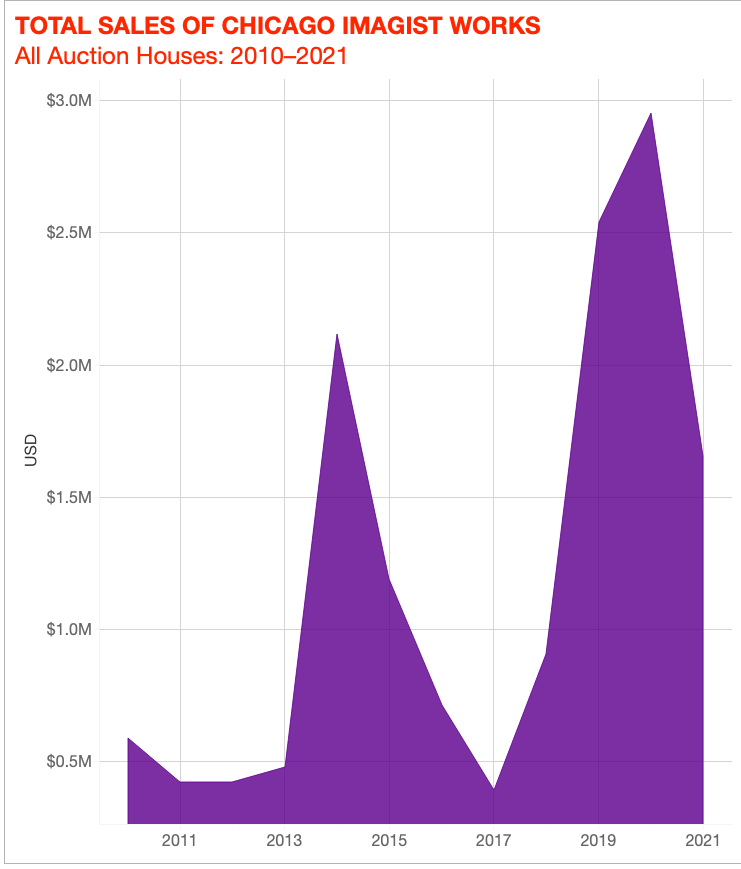
© 2022 Artnet Worldwide Corporation.
Phillips’s selling exhibition “Cooler by the Lake: Chicago Art 1965–1985” (through February 5) centers on the work of the Chicago Imagists, whose graphic figurative style presaged sizzling ultra-contemporary artists like Emily Mae Smith, Nicolas Party, and more by decades. Could the show heat up the auction sector’s historically lukewarm attitude toward Ed Paschke, Jim Nutt, and the other Imagists?
For a fuller picture of the Imagists’ legacy under, and beyond, the hammer, click through for Eileen Kinsella’s market dive.
____________________________________________________________________________
“The prices are absurd, and it is very upsetting to see artists’ work handled in this way—not just Thomas, but others whose work seems to have been similarly dumped… Frankly, I’m speechless.”
—Edinburgh-based dealer Richard Ingleby on the nearly unpublicized sale of 147 works solely provenanced to Christie’s-acquired (then Christie’s-shuttered) gallery Haunch of Venison at English auctioneer Bellmans. Nearly all lots sold for tiny slivers of their estimates and the artists’ private-market prices. Seven works by Ingleby-repped Thomas Joshua Cooper brought as little as £300 ($400). (Artnet News Pro)
____________________________________________________________________________
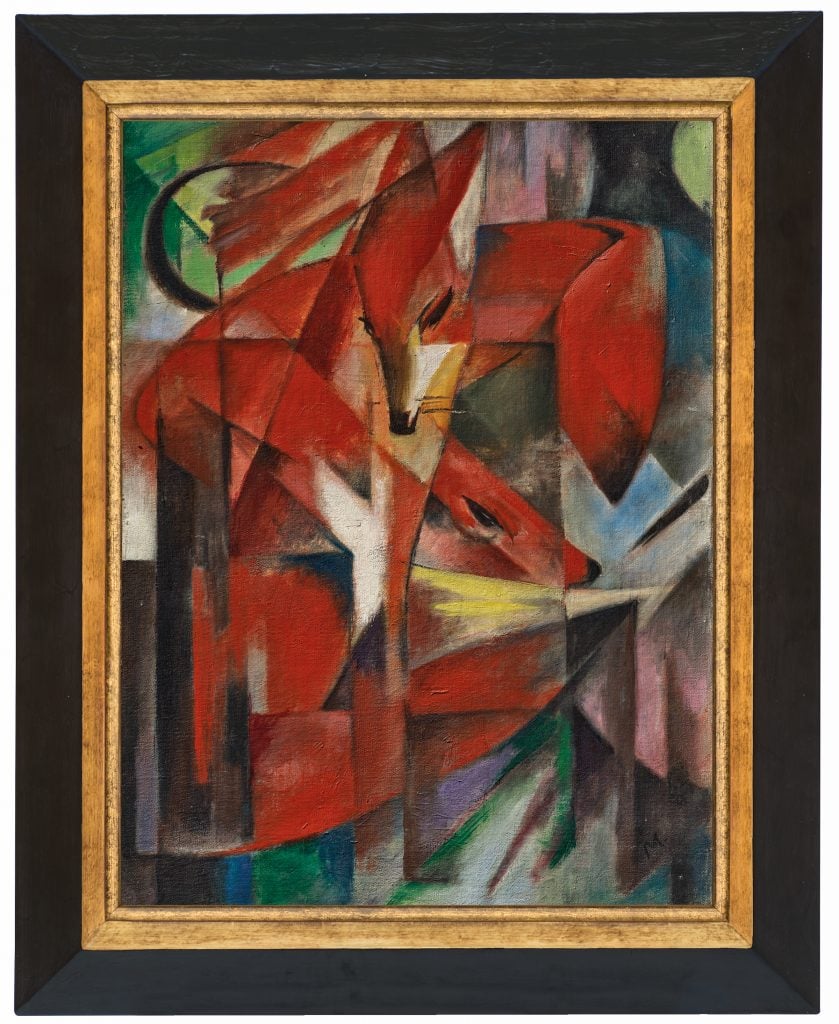
Courtesy of Christie’s.
____________________________________________________________________________
Estimate: £35 million ($46.8 million)
Selling at: Christie’s “20/21 Shanghai to London” sale
Sale date: March 1
The latest modernist canvas to rocket from a restitution investigation to the evening-sale spotlight is Franz Marc’s The Foxes (Die Fuchse). Provenance records show that the piece was acquired in 1928 by Kurt Grawi, a Jewish banker who was arrested by the Nazis during Kristallnacht, then was imprisoned in a concentration camp. Upon his release, Grawi quickly sold The Foxes to fund his and his family’s escape to Chile. The painting then wound its way through several owners before being donated to the Düsseldorf City Art Collection in 1962.
In 2015, Grawi’s descendants submitted a restitution claim seeking to shift the terms of the debate. Even though The Foxes had not been directly seized, they argued, the clear and present danger presented by the Third Reich effectively pressured Grawi into selling the work to survive. Last year, Germany’s Limbach Commission agreed, recommending that the painting be returned to Grawi’s heirs. Now they stand to earn millions of euros from the decision—while also opening the door to an even more open-minded (and likely, more active) chapter in the restitution saga.
The Foxes will travel for viewings in Hong Kong and New York this month, before returning to London for Christie’s mega-relay auction on March 1. Bidding commences in Shanghai, where Christie’s recently debuted a new office and gallery spaces. The event will also mark the house’s first live event in mainland China since the rise of COVID, meaning The Foxes will bring a fresh start in more ways than one.
____________________________________________________________________________
Select contributions by Naomi Rea.